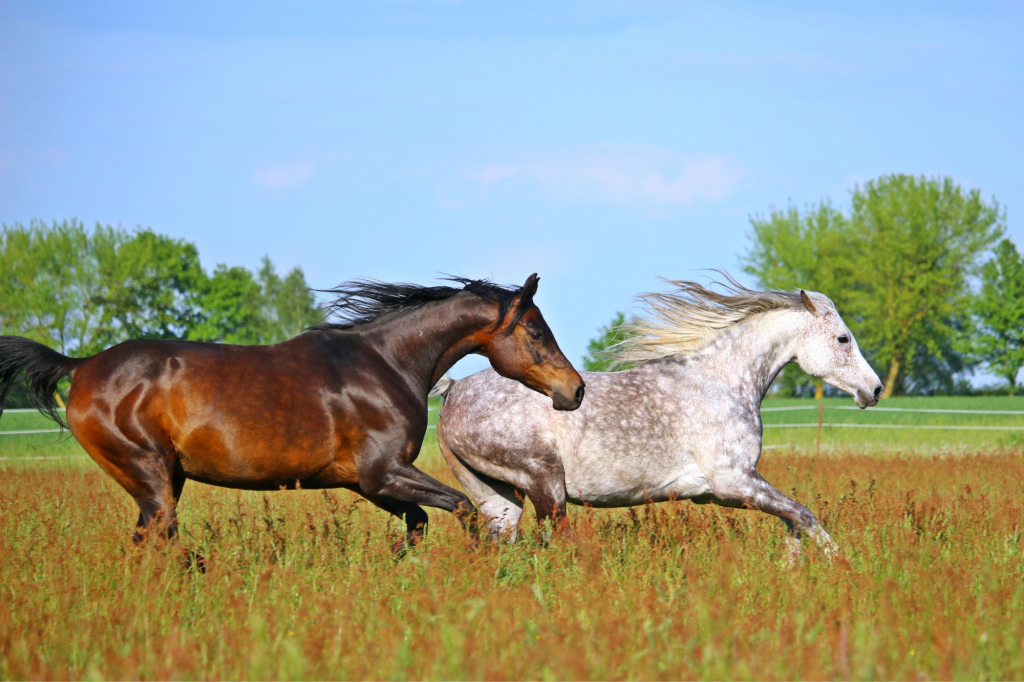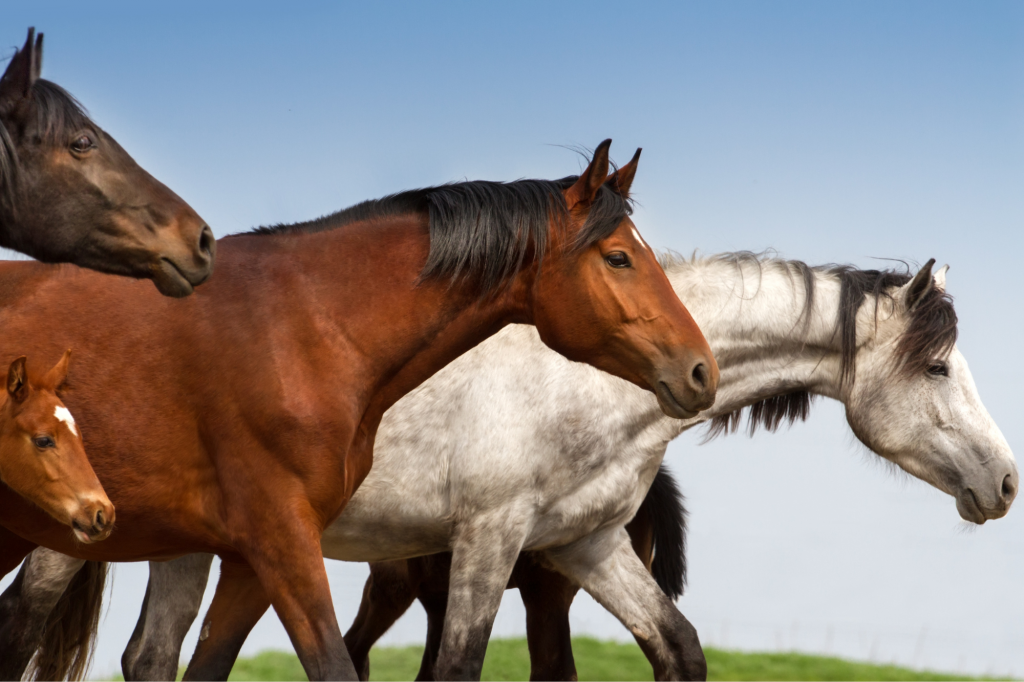
Vitamins in horse nutrition
25 October 2022
How to get a shiny coat for your horse
26 April 2023Minerals in horse nutrition: when and which ones to feed

Horses are composed of 70% water and 4% minerals. Without minerals, horses would not be able to metabolise fats, proteins and carbohydrates and there would be abnormalities in the functioning of nerves and muscles and, finally, bones may not support their weight. Minerals also help the blood to transport oxygen and help maintain the body’s acid-base and fluid balance. But are the minerals in the horse’s diet already present in the hay or do they have to be added through feed? Let’s learn more about these crucial nutrients for the horse.

What are minerals for the horse?

Most nutrition scholars distinguish minerals into two broad categories: macro elements, needed in relatively high concentrations in the diet, and microelements, needed in very small amounts.
Macroelements are calcium, phosphorus, sodium, potassium, chloride, magnesium and sulphur, while microelements include copper, iodine, iron, selenium, manganese, zinc, cobalt and fluoride.
What are the sources of minerals in a horse’s diet?

Horses obtain most of their minerals from hay and feed, but the concentration and availability of minerals varies depending on those in the soil, plant species and the conditions under which the plants were harvested, including the stage of maturity.
Are mineral requirements the same for everyone?

Studies have shown that horses under intense exercise have a higher requirement for certain minerals, and those in chelated form are useful for sport horses because they are significantly more bioavailable. The source of minerals must be constant in order to be useful for energy metabolism, tissue maintenance and a healthy, resilient immune system. Organic minerals are a particularly important choice for rations of young, growing horses. The correct amounts and ratios of many nutrients are essential for the development of bones, muscles and nerves, and the use of organic minerals can help ensure that minerals are properly balanced and absorbed.
What are the most bioavailable forms of minerals for the horse?
It is believed that chelated minerals are more digestible than non-chelated forms. In other words, chelation makes minerals more bioavailable (able to be absorbed and utilised for bodily functions), mainly by protecting them from the effects of other nutrients in the animal’s digestive tract
Why is it necessary to supplement rations with minerals for the horse?

In a natural environment where grazing animals roam over a large area, each animal encounters a wide variety of vegetation. Today’s horses, if they are grazed at all, are usually confined to relatively small paddocks with a limited variety of grasses and plants. Often the farmland has been subjected to decades of grazing or cultivation and their mineral reserves can be seriously depleted. Add to this the increasingly selected genetics, the heavy demands on growth, training and performance of our horses in recent years. It therefore becomes evident that mineral supplementation is necessary for horses to grow and express their full potential.
What are the benefits of a diet supplemented with minerals for the horse?

Few studies have been conducted on horses, but equine research has indicated that organic minerals may improve immune function through improved bioavailability. In one study, the diet of horses undergoing field trials was supplemented with copper in chelated form and was found to be useful for horses with developing orthopaedic disorders. In contrast, inorganic copper sulphate at comparable levels did not lead to similar improvements. Other studies have shown a link between the use of chelated minerals and an increase in the number of ovarian follicles produced per reproductive cycle and a reduction in the rate of early embryonic death.
Does diet affect mineral absorption in horses?
Mineral absorption can also be influenced by the amount of other nutrients in the diet, such as fat, indigestible fibre and vitamins, and by the pH balance of the gut, which can affect the solubility of elements.
What are the most frequent mineral deficiencies in horses?

Calcium or phosphorus deficiencies are the most common mineral deficiencies in horses. Growing, pregnant, lactating or exercising horses require higher levels of calcium and phosphorus than adult horses in the maintenance phase. This is due to the higher calcium and phosphorus requirements for bone development and maintenance. When requirements are high, it is necessary to supplement with balanced mineral feeds such as Osteo Foal.
Although the minimum ratio of calcium to phosphorus is 1:1, the National Research Council (NRC) recommends a ratio of 2:1, which corresponds to the ratio of calcium to phosphorus in bones. Researchers have found that a ratio of up to 6:1 is safe in horses. This ratio can be determined by looking at the calcium and phosphorus on the feed label and by analysing the hay. Most hay varieties contain more calcium than phosphorus, with leguminous hays, such as alfalfa, containing the highest levels. If you want to learn more, read our article on Calcium and Phosphorus balance in horses:

Sodium deficiency is also quite common: forage contains very low levels of it and commercial diets generally contain less than 0.5% salt, which means that most horses, even those receiving fortified feeds, may need more sodium in their diet. This is especially true for working horses or those living in hot, humid climates. In healthy horses, excess sodium is easily excreted in the urine, so it is a relatively safe addition to the horse’s diet. Supplementary feeds containing mineral salts in the ration such as Reidral + CY are sufficient to make up for these deficiencies.
Are mineral excesses possible in the horse?

All minerals can have adverse effects if ingested in excessive amounts, but in most cases there is a large safety zone. This is why even complementary feeds based on vitamins and minerals such as Aminotech, Megavit, Hemo Complex are formulated considering a basic intake of minerals with the hay and the basic feed.
The most notable exceptions are selenium and iodine, both of which can be easily overdosed, for which there are strict limits in horses. The table below shows the requirements for horses and the toxicity levels of minerals according to the NRC.
| Mineral | Daily amount per horse (ppm) | Toxicity levels (ppm) |
| Zinc | 60-70 | 9000 |
| Iodine | 0,2-0,3 | 5,0 |
| Fluorine | – | 50 |
| Lead | – | 80 |
| Selenium | 0,2-0,3 | 5,0 |
| Manganese | 60-70 | 4000 |
| Rame | 20-30 | 300-500 |
| Cobalto | 0,1 | 400 |
| Iron | 125 | 5000 |
Cobalt: supplementation and FEI – Mipaaf regulation
Although cobalt is an essential micronutrient for the synthesis of vitamin B12, over-physiological concentrations have been shown to induce performance enhancement in humans and rats, and there is evidence that its administration in high doses in horses poses a threat to their welfare.

Regulatory authorities, such as the FEI and Mipaaf, currently control the abuse of cobalt by considering it a prohibited substance. However, as cobalt can be present in physiological concentrations, a study was launched in 2017 to establish thresholds and to understand whether this mineral is present in good faith or administered for doping purposes. Cobalt in complementary feed takes these thresholds into account and serves to enable normal red blood cell production, the conversion of folates into active forms and the protection of the myelin sheaths of the nervous system.
How important is the balance of minerals in the horse?

Certain minerals have ratios in the equine diet that must be respected as the amount of one mineral present can affect the absorption and utilisation of another. The one we focus on most is the calcium-phosphorus link, but copper, zinc and iron (with the possible addition of magnesium and manganese) also form another, more complex link that has received a good deal of attention from researchers studying abnormal bone development in young horses. And there may be many other links that are not yet known. It is preferable to add complementary feeds that already take into account the proportions between the various elements.
To find out if your horse is getting the minerals it needs correctly, you need to turn to people who are experts in equine nutrition and this will prevent you from making mistakes. For more information visit our website or send us a message at email info@equiplanet.it
Follow us on Instagram
Bibliography
- Nutrition and equine performance. H F Hintz, J Nutr 1994
- Pharmacokinetics of inorganic cobalt and a vitamin B 12 supplement in the Thoroughbred horse: Differentiating cobalt abuse from supplementation. L L Hillyer, 2018
- https://ker.com/equinews/chelated-minerals-enhance-nutrient-bioavailability/
- Problems In Equine Nutrition. JD. Pagan, 2004

